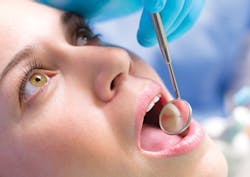Dental hygiene patient assessments
What are the rules in evaluating oral conditions?
Dental hygienists are expected to perform an "assessment" during the dental hygiene process of care. In fact, it is Standard 1 of the American Dental Hygienists' Association's Standards for Clinical Dental Hygiene Practice.1 Most state practice acts include language that reinforces this to be one of the primary duties and/or responsibilities of a registered dental hygienist.
Unfortunately, many hygienists have shared that this procedure is one in which their offices either limit their time to perform it completely or delete parts of it entirely. The objective seems to be to put more patients in their schedule for "cleanings" in order to increase production. This is not only a disservice to the patients we treat, but it puts both the hygienist and the dentist into a tenuous situation from a risk management point of view.
-------------------------------------------------------------------
Consider reading these articles:
- We need a new CDT code
- Gems in the Inbox
- New research supports assessing risk, preventive treatment for periodontal disease
-------------------------------------------------------------------
By virtue of licensure, dental hygienists agree to uphold the statutes of their state practice acts as they relate to their profession; however, dentists and dental hygienists seem to differ on exactly what is meant by the term "assessment" and what it is meant to include. Whether it is a difference in semantics or merely a differing of professional responsibilities, a review of terms may be helpful. Hygienists can then evaluate whether they are performing up to the standard of care according to their laws and regulations as well as for their patients' general and oral health.
During the past 40 years, there have been healthy discussions among dental professionals as to what is meant by evaluation, assessment, diagnosis, and inspection. The American Dental Association has made it clear that only a dentist can provide and bill for an oral evaluation (there are no examination codes). It would be improper to report any evaluation unless the doctor has physically examined (hands in mouth!) and evaluated the patient.2 These definitions and synonyms include:3
Evaluation
>> To judge the value or condition of someone or something in a careful and thoughtful way
Synonyms: assessment, judgment, estimation
Assessment
>> The act of making a judgment about something
Synonyms: judgment
Diagnosis
>> The act of identifying a disease, illness, or problem by examining someone or something
>> Investigation or analysis of the cause or nature of a condition, situation, or problem
Synonyms: analysis, judgment, finding, conclusion
Inspection
>> The act of looking at something closely in order to learn more about it, to find problems, etc.
Synonyms: examination, investigation, inquiry
With so much obvious overlap of terms and their definitions, it is important to look to other sources to identify what a dental hygiene assessment includes. The ADHA is the largest national organization representing the professional interests of the more than 150,000 registered dental hygienists across the country. This organization provides hygienists with the Standards for Clinical Dental Hygiene Practice,4 a resource providing guidance when it comes to determining "patient-centered and evidence-based care" (may be downloaded at www.adha.org). The Dental Hygiene Process of Care identifies five components of which the first standard is Assessment.
Assessment is the systematic collection, analysis, and documentation of the oral and general health status and patient needs. The dental hygienist conducts a thorough, individualized assessment of the person with or at risk for oral disease or complications. The assessment process requires ongoing collection and interpretation of relevant data.
This assessment is comprised of three parts. The following is an abbreviated description from the above document (pp. 6-8).
- Patient history -- record personal profile information, current and past dental and dental hygiene oral health practices, and collect specific health history data.
- Perform a comprehensive clinical evaluation -- including examination of the head and neck as well as oral cavity regions, oral cancer screening, evaluation of trauma and TMJ assessment; evaluate for further diagnostics including radiographs; a comprehensive periodontal evaluation, and a comprehensive hard tissue evaluation.
- Risk assessment is a qualitative and quantitative evaluation gathered from the assessment process to identify any risks to general and oral health. More than a dozen examples of factors that should be evaluated to determine the level of risk (high, moderate, low) are listed.
There will be many hygienists reading this who will give a sigh of relief to know they have been providing their patients with comprehensive care based on the above descriptions. They take the time to discuss and document all aspects of the patient's general and oral health. Their employers recognize not only the benefits of providing the additional time; they realize that comprehensive assessments allow them to develop comprehensive treatment plans that the patients will accept. When this is done, there is low risk management potential.
Other hygienists will look at the above descriptions and say they do not have time (or their employer will not give them time) to perform all of these procedures. They may even lament that the ADHA does not dictate what is done in their practice … that their employer sets the protocols in the office, and that there is no way things will change. When this is done, the practice is not providing comprehensive care to their patients and there is high risk management potential. As a licensed professional, dental hygienists need to remember they can be sued for negligent care along with their employer if the patient pursues litigation. "I only did what my employer told me to do" will not be a valid defense.
Hygienists who need a recognized specialist organization to define what procedures should be included during an assessment can turn to the American Academy of Periodontology for help. The AAP is an 8,400-member professional organization for periodontists, who are the recognized specialists in the prevention, diagnosis, and treatment of diseases affecting the gums and supporting structures of the teeth, and in the placement of dental implants. Periodontists are also dentistry's experts in the treatment of oral inflammation.5
In July of 2011, the Journal of Periodontology published a statement, "Comprehensive Periodontal Therapy: A Statement by the American Academy of Periodontology," which "sets forth the scope, objective, and procedures that constitute periodontal therapy." 6
This statement is provided to assist all members of the dental team who provide periodontal care and should be considered in its entirety. This statement may also be useful to those who supervise, teach, or regulate the provision of periodontal therapy.
The recommendations set forth here directly relate to dental hygienists who provide the periodontal care in most dental practices. It is paramount for hygienists to recognize the expectations for completing a periodontal evaluation prior to therapy as recommended by the "recognized specialists," the AAP. The following is an abbreviated description from the above document:
Periodontal Evaluation (assessment procedures)
>> Comprehensive assessment of patient's current health status, history of disease and risk characteristics in order to determine periodontal diagnosis. Risk factors should be identified at least on an annual basis.
>> Extra- and intraoral examination
>> Examination and assessment of teeth and supporting structures
>> Assessment of presence, degree, distribution of plaque/biofilm, calculus
>> Dental exam to include caries assessment, occlusal examination
>> Interpretation of current and comprehensive diagnostic-quality radiographs
>> Evaluation of potential periodontal-systemic interrelationships
>> Assessment of the need of dental implants
>> Determination and assessment of patient risk factors such as age, diabetes, smoking, cardiovascular disease, and other systemic conditions associated with and/or progression of periodontal disease.
The article goes on to further describe (1) establishing a diagnosis, prognosis, and treatment plan, (2) informed consent and patient records, (3) treatment procedures, (4) evaluation of therapy, and (5) periodontal maintenance therapy. Hygienists would be prudent to download this statement from the AAP and share with their employers as they discuss integrating these procedures into their appointment protocols.
Many of these assessment procedures are routinely performed during not only adult prophylaxis appointments but periodontal maintenance appointments as well. And with that, there are appointments that do not require an oral evaluation by the dentist due to frequency (three-month periodontal maintenance appointments do not usually require the dentist to see the patient every time) or the dentist is out of the office (in some states, the hygienist may work on patients of record when the dentist is out of the office). In either case, hygienists routinely provide clinical assessments for these patients.
The ADA developed a prediagnostic code for CDT-2013 to fill the void when it came to dental assessments by practitioners other than dentists as long as they are acting within the scope of their state law.7 Prior to this code, there was no way to acknowledge and document these necessary assessments and, more importantly, no specific procedure code to use for submission to insurance carriers or patients for reimbursement.
Assessment of a Patient
A limited clinical inspection is performed to identify possible signs of oral or systemic disease, malformation, or injury, and the potential need for referral for diagnosis and treatment.
The assessment code (D0191) can be utilized by dental hygienists but only when a complete assessment has been performed, whether it is defined by statute, ADHA, or the AAP.
Hygienists are encouraged to help their practices establish identifiable assessment protocols that align with an organization which represents their profession as the recognized prevention and nonsurgical periodontal care specialist. If you and your employer ever end up in court, you would want to be assured that your resources can validate and support your treatment for the patient.
KATHY S. FORBES, RDH, BS, has been a dental hygienist, educator, speaker, and author for over 30 years. She speaks frequently about the correct classification, documentation, treatment planning, procedure code selection, and long-term case management for patients with periodontal disease. She is a regular contributing author for the Insurance Solutions Newsletter, a national publication for Dr. Charles Blair and Associates, where she addresses issues related to dental hygiene procedures and proper billing practices. Kathy is also owner of Professional Dental Seminars, Inc., a continuing education provider. She can be reached at 253-670-3704 or [email protected].
Resources
1. Standards of Clinical Dental Hygiene Practice published by the American Dental Hygienists' Association; Chicago, IL; March 2008.
2. Coding with Confidence: The "Go To" Dental Insurance Guide, CDT-2013 Edition published by Dr. Charles Blair and Associates, Inc; Belmont, NC; 2012.
3. Merriam-Webster Online Dictionary, 2013.
4. Standards of Clinical Dental Hygiene Practice published by the American Dental Hygienists' Association; Chicago, IL; March 2008.
5. Vision and Mission Statement of the American Academy of Periodontology at www.perio.org.
6. Comprehensive Periodontal Therapy: A Statement by the American Academy of Periodontology from the Journal of Periodontology 2011, pp. 943-949.
7. Using the CDT Code from CDT-2013 (p. iv) published by the American Dental Association; Chicago, IL; 2012.
About the Author

Kathy S. Forbes, BS, RDH, FADHA
Kathy S. Forbes, BS, RDH, FADHA, brings over four decades of passion and expertise to the dental profession as a clinician, educator, speaker, author, and consultant. Known for turning complex coding topics into clear, practical insights, Kathy helps dental teams connect accurate documentation and coding with quality patient care. Kathy serves as a Director for the DentalCodeology Consortium, where she works with hygienists from across the country to review and develop dental hygiene–related procedure codes and presents testimony annually to the ADA’s Code Maintenance Committee.
Reach her at [email protected].
